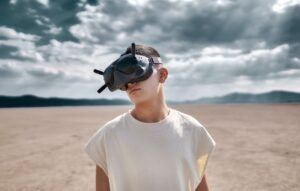Deepfake Hologram
Deepfake technology has come a long way in recent years, allowing for the creation of highly realistic holographic images and videos. Combining deep learning algorithms with powerful graphics processing capabilities, deepfake holograms have immense potential in various industries. This article explores the concept of deepfake holograms, their applications, and the ethical concerns surrounding their use.
Key Takeaways:
- Deepfake holograms utilize deep learning algorithms and powerful graphics processing to create highly realistic holographic images and videos.
- Deepfake holograms can find applications in entertainment, education, virtual communication, and more.
- Ethical concerns such as misuse, misinformation, and invasions of privacy arise with the rise of deepfake holographic technology.
Deepfake technology uses machine learning algorithms to manipulate or replace elements of an existing image or video with fake counterparts. This technology takes advantage of artificial intelligence to create synthetic media that is challenging to distinguish from reality. In the case of deepfake holograms, these realistic visuals are projected as 3D holographic representations. *The advancements in deepfake technology have rendered it increasingly difficult for the untrained eye to detect manipulated holographic content*.
Applications of Deepfake Holograms
The potential applications of deepfake holograms are vast, and there are several industries that could benefit from this cutting-edge technology. Here are a few notable examples:
- Entertainment: Deepfake holograms could revolutionize the entertainment industry by enabling realistic virtual performances of deceased artists or allowing actors to portray characters that are physically impossible for them.
- Education: Deepfake holograms have the potential to enhance learning experiences by bringing historical or fictional characters to life, allowing students to interact with them in a more engaging manner.
- Virtual Communication: Deepfake holograms can enable realistic virtual meetings and conferences, making remote communication more immersive and interactive.
| Industry | Potential Applications |
|---|---|
| Entertainment | Realistic virtual performances, impossible character portrayals |
| Education | Interactive learning with historical or fictional characters |
| Virtual Communication | Immersive remote meetings and conferences |
However, the rise of deepfake holograms also brings forth ethical concerns that need to be addressed. This technology can be misused for malicious purposes, such as spreading misinformation or creating false evidence. There are also privacy concerns, as deepfake holograms could potentially be used to invade someone’s privacy by creating fabricated videos or images. *It is imperative that society establishes regulations and safeguards to prevent the misuse and potential harm caused by deepfake holograms*.
Ethical Concerns
- Misuse and spread of misinformation
- Creation of false evidence
- Invasions of privacy
Overall, the advancements in deepfake hologram technology have shown immense potential in various industries. However, the ethical implications must be carefully considered and addressed to prevent potential harm. By regulating the use of deepfake holograms and implementing security measures, society can reap the benefits of this technology while mitigating the associated risks.
| Ethical Concern | Associated Risks |
|---|---|
| Misuse and spread of misinformation | Mistrust, false narratives |
| Creation of false evidence | Legal consequences, wrongful accusations |
| Invasions of privacy | Loss of personal autonomy, reputational harm |
In conclusion, deepfake hologram technology presents intriguing possibilities for entertainment, education, and virtual communication. However, it is crucial to acknowledge and address the ethical concerns arising from its use. By doing so, we can strike a balance between reaping the benefits of this innovative technology and protecting society from potential harm.

Common Misconceptions
Misconception 1: Deepfake Holograms are Inherently Fake
One common misconception about deepfake holograms is that they are always fake or fabricated. However, deepfake holograms can be created using real footage and advanced technology, making them appear incredibly realistic.
- Deepfake holograms often use real videos as the basis for their creation.
- The technology behind deepfake holograms can convincingly manipulate facial and body movements.
- Deepfake holograms can be used to recreate historical figures or past events with remarkable accuracy.
Misconception 2: Deepfake Holograms are Limited to Entertainment Purposes
Another misconception is that deepfake holograms are solely used for entertainment purposes. While they can certainly be used in the entertainment industry, their applications go beyond that.
- Deepfake holograms have potential in fields such as education and training.
- They can be utilized for realistic simulations and scenarios without actual physical risk.
- Deepfake holograms in telepresence technology can enable people to remotely communicate as if they were physically present.
Misconception 3: Deepfake Holograms are Easy to Detect
Many people assume that deepfake holograms can be easily detected due to their synthetic nature. However, deepfake technology has advanced significantly, making detection more challenging.
- Modern deepfake holograms can replicate even subtle facial expressions and micro-expressions.
- Advanced algorithms can generate convincing holographic human movements.
- Deepfake detection techniques are continuously being developed to keep up with the rapidly advancing technology.
Misconception 4: Deepfake Holograms Pose No Real Threat
Some may believe that deepfake holograms don’t pose any significant threat to society. However, there are potential dangers and risks associated with their misuse.
- Deepfake holograms could be used for malicious purposes such as spreading false information or propaganda.
- They can potentially impact public perception and trust.
- Deepfake holograms may raise ethical concerns, particularly when used without proper consent or permission.
Misconception 5: Deepfake Holograms Are Only Developed by Professionals
It is a common misconception that deepfake holograms are exclusively created by professionals with specialized knowledge. However, with the increasing availability of tools and resources, anyone with basic skills can create a deepfake hologram.
- Various software and online platforms have made deepfake creation accessible to a wider audience.
- Detailed tutorials are available to guide individuals in creating their own deepfake holograms.
- The democratization of deepfake technology poses potential risks due to its ease of use.

Table 1: Top Deepfake Hologram Uses
The following table displays various industries and sectors that have incorporated deepfake hologram technology:
| Industry/Sector | Applications |
|---|---|
| Entertainment | Live concerts, virtual actors |
| Education | Virtual lecturers, historical figures |
| Medicine | Patient education, surgical training |
| Advertising | Product showcases, brand ambassadors |
Table 2: Factors Influencing Deepfake Hologram Adoption
This table highlights key factors impacting the rate at which deepfake hologram technology is being embraced:
| Factor | Description |
|---|---|
| Cost | Expense of implementing the technology |
| Performance | Quality and believability of holograms |
| Ethical considerations | Controversies surrounding the creation and use of deepfakes |
| Regulation | Laws governing deepfake use |
Table 3: Major Players in Deepfake Hologram Development
The following table presents companies and organizations at the forefront of advancing deepfake hologram technology:
| Company/Organization | Notable Contributions |
|---|---|
| Microsoft | Real-time hologram synthesis algorithms |
| Disney Research | Face-swapping techniques for animated characters |
| NVIDIA | Hardware acceleration for realistic holographic rendering |
| MIT Media Lab | Advancements in volumetric capture technology |
Table 4: Public Opinion on Deepfake Holograms
Here are some findings regarding public perception of deepfake hologram technology:
| Opinion | Percentage |
|---|---|
| Excited about possibilities | 45% |
| Concerned about misuse | 32% |
| Unsure or neutral | 23% |
Table 5: Deepfake Hologram vs. Traditional Hologram
The table below compares deepfake hologram technology with traditional holograms:
| Aspect | Traditional Hologram | Deepfake Hologram |
|---|---|---|
| Creation complexity | High | Medium |
| Realism | Medium | High |
| Dynamic capabilities | Low | High |
Table 6: Deepfake Hologram Applications in Politics
Here are examples of deepfake holograms being employed within the political arena:
| Politician | Usage |
|---|---|
| Barack Obama | Providing endorsements for candidates |
| Vladimir Putin | Addressing large crowds remotely |
| Angela Merkel | International conferences through telepresence |
Table 7: Deepfake Hologram Implementation Challenges
Consider the following challenges faced when incorporating deepfake holograms:
| Challenge | Description |
|---|---|
| Data privacy | Protecting personal information used for deepfake creation |
| Real-time processing | Generating holograms with minimal latency |
| Content variability | Ensuring diverse and inclusive representation in holograms |
Table 8: Deepfake Hologram Licensing Models
This table identifies different licensing models associated with deepfake hologram technology:
| Model | Description |
|---|---|
| Purchase | One-time, upfront payment for full access |
| Subscription | Monthly or annual fee for continuous hologram usage |
| Pay per use | Paying based on the number of hologram renderings |
Table 9: Potential Deepfake Hologram Threats
The following table outlines potential threats posed by the misuse of deepfake hologram technology:
| Threat | Impact |
|---|---|
| Political manipulation | Dissemination of false information to influence public opinion |
| Identity theft | Impersonation of individuals for malicious purposes |
| Creation of fake evidence | Undermining trust in legal proceedings |
Table 10: Deepfake Hologram Legislation by Country
This table showcases different countries and their legislative actions regarding deepfake holograms:
| Country | Status |
|---|---|
| United States | No specific laws, relying on existing regulations |
| China | Imposed restrictions on deepfake creation and distribution |
| European Union | In the process of formulating regulations |
Deepfake hologram technology has garnered significant attention due to its potential in various fields. Table 1 highlights the use of deepfake holograms in entertainment, education, medicine, and advertising. Factors influencing its adoption, such as cost and ethical considerations, are discussed in Table 2. The table also sheds light on the major players propelling deepfake hologram development, including Microsoft, Disney Research, NVIDIA, and MIT Media Lab (Table 3). Public opinion on this technology varies, as demonstrated in Table 4.
The comparison between deepfake and traditional holograms is presented in Table 5, emphasizing the advantages of deepfake holograms in terms of realism and dynamic capabilities. Additionally, political applications of deepfake holograms are showcased in Table 6, featuring famous politicians like Barack Obama, Vladimir Putin, and Angela Merkel.
However, the implementation of deepfake holograms encounters several challenges as outlined in Table 7, including data privacy and real-time processing. Different licensing models for accessing deepfake hologram technology are discussed in Table 8, ranging from purchase to subscription-based approaches. Potential threats associated with deepfake holograms are listed in Table 9, such as political manipulation and identity theft.
Finally, Table 10 provides an overview of deepfake hologram legislation in various countries, including the United States, China, and the European Union. As deepfake hologram technology evolves, it is essential to address the associated challenges and establish appropriate guidelines to ensure its ethical and responsible usage.
Frequently Asked Questions
Deepfake Hologram FAQs
- What is a deepfake hologram?
- A deepfake hologram refers to a realistic three-dimensional representation of a person or object created using deep learning techniques.
- How are deepfake holograms created?
- Deepfake holograms are created by training a deep learning model on a large dataset of images or videos of the subject.
- What are the potential applications of deepfake holograms?
- Deepfake holograms have various potential applications, including entertainment, education, and communication.
- Are deepfake holograms ethically concerning?
- Deepfake holograms raise ethical concerns similar to those associated with traditional deepfake technology.
- Can deepfake holograms be easily distinguished from real humans?
- As deepfake hologram technology advances, it becomes more challenging to distinguish between real humans and holographic representations.
- What are some potential risks associated with deepfake holograms?
- Some potential risks associated with deepfake holograms include the creation of realistic fake news videos or speeches, identity theft, and invasion of privacy.
- How can deepfake holograms be used in education?
- Deepfake holograms can enhance education by providing immersive and interactive learning experiences.
- Can deepfake holograms be used in live performances?
- Yes, deepfake holograms can be used in live performances.
- What are some challenges in developing deepfake holograms?
- Developing deepfake holograms involves addressing various challenges.
- Are there any regulations in place for deepfake holograms?
- Currently, regulations specific to deepfake holograms are limited.




